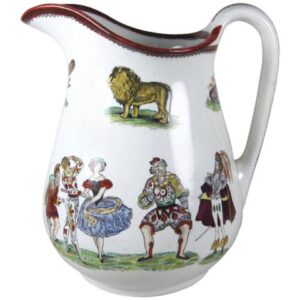About Transferware

Elsmore & Foster ‘Harlequin’ Jug
1853-1871
Transferware is a style of ceramics and pottery most often seen in dinnerware and other table items. It uses transfer printing, a decorative technique which was developed in England in the mid-18th century, particularly around the Staffordshire region. Transferware can be earthenware, ironstone, porcelain, or china. The invention of transfer printing originally made fine china affordable for middle class families, but transferware has since become a valuable collector’s item.
The transfer printing process’s invention is attributed to John Brooks, an Irish engraver who began printing on enamel in the early 1750s. The process starts with an engraved copper plate similar to those used for making paper engravings. The plate is used to print the pattern on tissue paper, then the tissue paper transfers the wet ink to the ceramic surface. The ceramic is fired in a low temperature kiln to fix the pattern. This can be done over or under the glaze, but the underprinting method is more durable. The process produces fine lines similar to the engraved prints in old books. Hand painted polychrome accents were sometimes added to enhance the design, as shown in the jug featured on this page. Before transfer printing ceramics were hand painted, a laborious and costly process.
Thousands of transferware patterns exist. Early patterns imitated designs from the Orient, but transferware expanded to depict historical scenes, pastoral landscapes, and recreational activities. When a niche market developed in the United States, manufacturers depicted images from American history, including scenes from the Lewis and Clark expedition, historical buildings, and figures and events. Cobalt blue, a favored import from China, continued in popularity after transferware’s development. More blue and white items were sold than any other color combination. Red, pink, brown, black, gray, yellow, purple, and green also became fashionable, and the United States imported many multicolored items.
Collecting antique transferware has become popular in recent decades. Transferware’s worth depends on date, rarity of pattern, and print quality. Obscurity makes unusual colors and transferware with no identifiable manufacture more desirable. The most collectible items were made in the early 19th century.
Collectors use a variety of cues to date transferware. Until 1883, items from England often had a datable diamond-shaped registration mark on the underside. In 1884, England’s patent office began registering patterns with identification numbers. Because of the McKinley Tariff Act, transferware made after 1891 often carries the words “Made in England.”



A source print for the platter, “Ancient Tomb on the Ganges” made by John Hall & Sons, 1814-1832, Burslem, Staffordshire, England.

